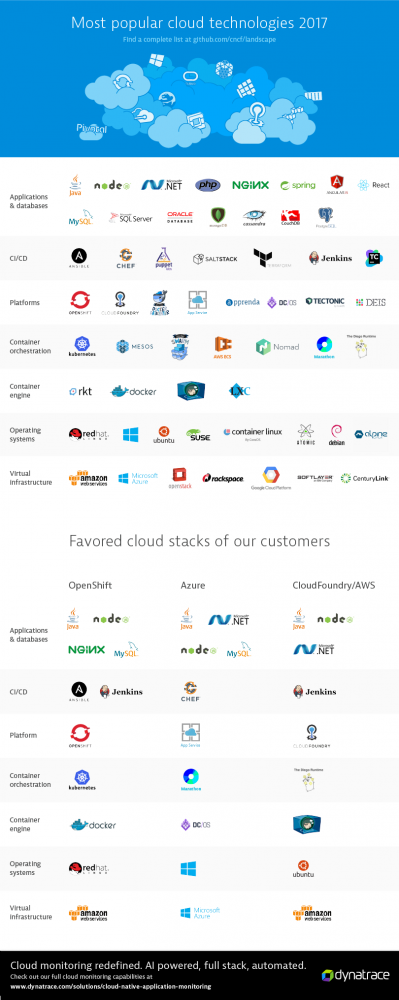Establishing a cloud infrastructure: These are the questions you should ask yourself beforehand
The need for flexible and fully scalable IT infrastructures is growing. One solution approach for more and more companies is cloud computing. Many companies are in the process of positioning themselves accordingly. According to IDC analysts, the trend towards cloud infrastructures will intensify in the coming years.

Being in the cloud is not everything. The complex architectures and myriad moving parts of a cloud ecosystem require modern monitoring capabilities; traditional approaches no longer work here. Anyone implementing cloud infrastructures for business-critical apps - whether on AWS, Azure, Google Cloud, OpenStack, or CloudFoundry - should be aware of the need for modern monitoring capabilities, according to the monitoring specialists at Dynatrace note the following points:
- How easy is cloud monitoring to implement, configure and maintain? As environments become increasingly complex, ease of deployment and use of applications becomes a must. Traditional monitoring solutions often require too many manual processes and configurations. This is one reason why most companies today can only monitor 5 to 10 percent of their applications and lose sight of dependencies and availability of business-critical services. The remedy here is a monitoring solution that already uses largely automated processes - from the discovery of the cloud environment to the creation of baselines and the analysis of problem causes.
- Are there real-time insights into the health of cloud resources? Whether it's a public, private or hybrid cloud, a virtualized data center, or deploying applications on CloudFoundry, organizations should have complete visibility into the health of the entire cloud-based architecture in real time. Only then can you determine if they have their containers under control, how well load balancers are working, and how hypervisor dynamics are doing. There are so many changing components in a cloud infrastructure that determining the root cause of deviating system behavior is very difficult. That's why enterprises should choose a cloud monitoring solution designed from the ground up for dynamic environments. It can illuminate all blind spots and keep up with all the changes in dynamic environments.
- Firefighting at the infrastructure level or comprehensive application performance monitoring? A solid cloud infrastructure is the backbone of any successful business, but ultimately it all depends on the applications. When they fail, disappointment among users is high. Applications can span many layers of technology, with components ranging from the cloud to the data center to the mainframe. To get a complete view of all applications, monitoring must be possible from multiple perspectives, including digital experience analytics, application performance management, and cloud and infrastructure management. Therefore, enterprises should use a unified monitoring tool that provides an overall view of the cloud infrastructure with all applications running on it.
- How quickly can the causes of problems be identified? Many companies struggle with overload due to far too many error messages. This is often due to the use of different monitoring tools for data centers, hosts, processes and services. When one of these components slows down or fails, it can set off a chain reaction of hundreds of subsequent errors. Then the IT team is virtually drowning in alerts. That's because traditional tools display countless metrics and charts, but leave it to humans to correlate and interpret that information. The solution lies in showing dependencies and correlations. If every transaction is captured and tagged at all times, the IT professional in charge receives data based on correlations. These hard facts reliably show him what actually triggered the system problems. A quick representation of the cause of the problem is worth its weight in gold when financial values and the company's reputation are at stake.
- How are performance baselines generated in ultra-dynamic environments? Creating performance baselines for cloud infrastructure monitoring is not straightforward. Traditional APM solutions can require time-consuming and potentially error-prone manual processes here. This is particularly because they rely on averages and transaction samples to determine normal performance. Averages, however, are ineffective because they mask underlying problems by balancing positive and negative outliers. Transaction examples, on the other hand, can lead to false-negative results. For effectively usable cloud infrastructure performance baselines, organizations need a tool that leverages percentiles (mean and slowest 10%) based on completely gapless data. The percentiles thereby show what is really happening, i.e. how most users actually experience the application and site.
- Does cloud monitoring include integrated log monitoring? Integrated log management and log analysis are among the most important functions of monitoring solutions today. This is because monitoring application performance and analyzing related log files of processes with the same tool helps DevOps, development and quality assurance teams to perform their tasks quickly and efficiently. If log analysis is one of the important tasks of their monitoring process, companies should choose a solution that already includes this feature. Direct access to all log content related to business-critical processes extends the reach of monitoring well beyond traditional APM data sources.
- Does the monitoring solution scale based on business needs? Last but not least, attention must be paid to the scalability of the monitoring tool. Modern cloud environments use thousands of nodes with hundreds of technologies distributed across data centers worldwide. While more and more monitoring tools can be installed for each silo, questions then quickly arise such as, "How far can the system scale?" and "How long before a newer, faster or larger solution is needed?" Choosing a monitoring solution that provides real-time insights into cloud components is important. But ensuring it doesn't break down as the environment expands is critical. Therefore, organizations should choose a monitoring tool that is designed for large application environments and can therefore scale as needed.
(Visited 91 times, 1 visits today)









